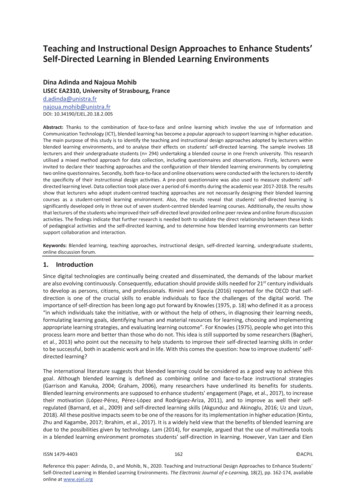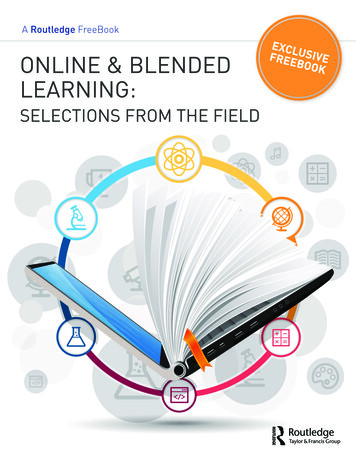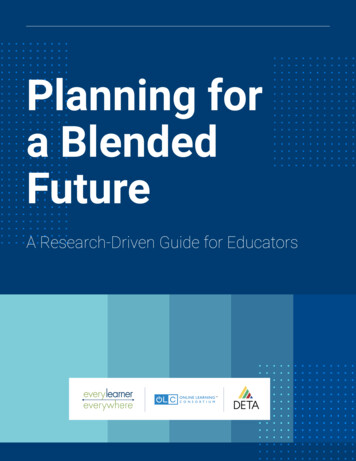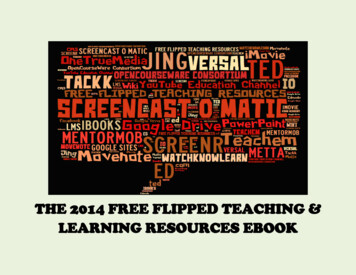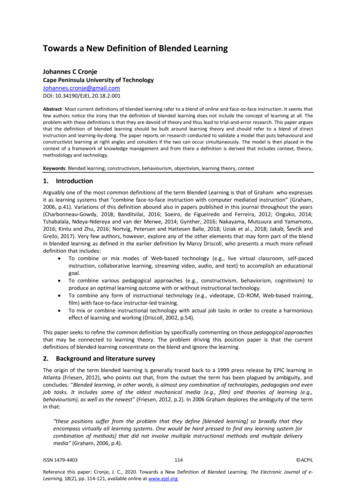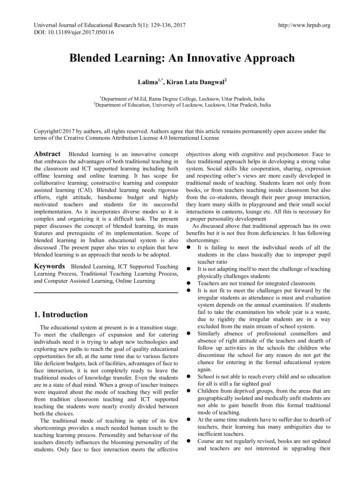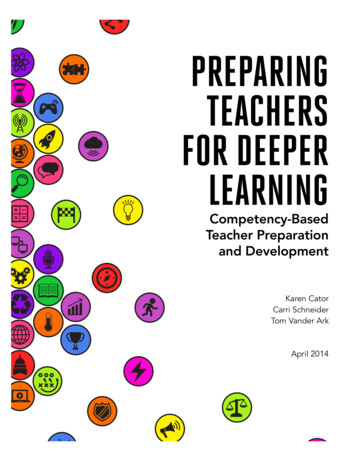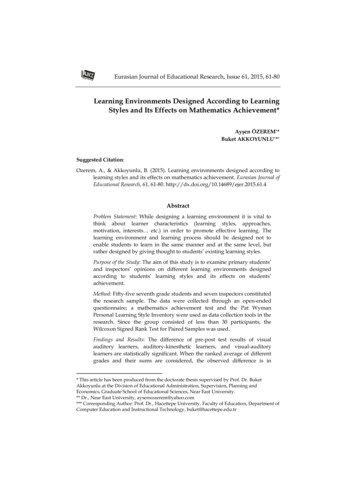
Transcription
Teaching in Blended Learning EnvironmentsTeaching in Blended Learning Environments interior.indd 113-11-21 3:58 PM
Issues in Distance EducationSeries Editors: Terry Anderson and David WileyDistance education is the fastest-growing mode of formal and informalteaching, training, and learning. Its many variants include e-learning, mobilelearning, and immersive learning environments. The series presents recentresearch results and offers informative and accessible overviews, analyses,and explorations of current issues and the technologies and services used indistance education. Each volume focuses on critical questions and emergingtrends, while also taking note of the evolutionary history and roots of thisspecialized mode of education and training. The series is aimed at a wide groupof readers including distance education teachers, trainers, administrators,researchers, and students.series titlesTheory and Practice of Online Learning, second editionedited by Terry AndersonMobile Learning: Transforming the Delivery of Education and Trainingedited by Mohamed AllyA Designer’s Log: Case Studies in Instructional Designby Michael PowerAccessible Elements: Teaching Science Online and at a Distanceedited by Dietmar Kennepohl and Lawton ShawEmerging Technologies in Distance Educationedited by George VeletsianosFlexible Pedagogy, Flexible Practice:Notes from the Trenches of Distance Educationedited by Elizabeth Burge, Chère Campbell Gibson, and Terry GibsonTeaching in Blended Learning Environments:Creating and Sustaining Communities of Inquiryby Norman D. Vaughan, Martha Cleveland-Innes and D. Randy GarrisonTeaching in Blended Learning Environments interior.indd 213-11-21 3:58 PM
Teaching in Blended LearningEnvironmentsCreating and Sustaining Communities of InquiryNorman D. VaughanMartha Cleveland-InnesandD. Randy GarrisonTeaching in Blended Learning Environments interior.indd 313-11-21 3:58 PM
Copyright 2013 Norman D. Vaughan, Martha Cleveland-Innes, andD. Randy GarrisonPublished by au Press, Athabasca University1200, 10011 – 109 Street, Edmonton, AB T5J 3S6isbn 978-1-927356-47-0 (print) 978-1-927356-48-7 (pdf)978-1-927356-49-4 (epub)Cover and interior design by Sergiy Kozakov.Printed and bound in Canada by Marquis Book Printers.Library and Archives Canada Cataloguing in PublicationVaughan, Norman D., 1960Teaching in blended learning environments : creating and sustainingcommunities of inquiry / Norman D. Vaughan, Martha Cleveland-Innes, andD. Randy Garrison(Issues in distance education series)Includes bibliographical references and index.Issued also in electronic formats.isbn 978-1-927356-47-01. Education, Higher—Computer-assisted instruction. 2. Teaching—Computer network resources. 3. Blended learning. 4. Internet in highereducation. I. Cleveland-Innes, M. II. Garrison, D. R. (Donn Randy) III. Title.IV. Series: Issues in distance education series.LB2395.7.V39 2013371.3C2013-901785-2We acknowledge the financial support of the Government of Canadathrough the Canada Book Fund (cbf) for our publishing activities.Assistance provided by the Government of Alberta, AlbertaMultimedia Development Fund.This publication is licensed under a Creative Commons License,Attribution–Noncommercial–No Derivative Works 2.5 Canada: seewww.creativecommons.org. The text may be reproduced for noncommercial purposes, provided that credit is given to the originalauthor.To obtain permission for uses beyond those outlined in the CreativeCommons license, please contact au Press, Athabasca University, ataupress@athabascau.ca.Teaching in Blended Learning Environments interior.indd 413-11-21 3:58 PM
ContentsviiList of TablesviiiList of FiguresPrefaceonetwothreefour1Conceptual Framework7Design 19Facilitation 45Direct onclusion121Appendix 127References131Index 139Teaching in Blended Learning Environments interior.indd 513-11-21 3:58 PM
Teaching in Blended Learning Environments interior.indd 613-11-21 3:58 PM
List of TablesTable 2.1.Examples of activities for establishing a climate that willsupport open communication and cohesion 28Table 2.2.Aligning learning outcomes, assessment activities, face-to-faceand online learning opportunities, and technology tools 37Table 2.3.Examples of activities that support systematic inquiry,discourse, and reflection3850Table 3.1.Facilitating social presence face-to-face and onlineTable 3.2.Facilitating cognitive presence face-to-face and onlineTable 4.1.Inquiry-based project rubricTable 4.2.Sample learning contractTable 4.3.Practical inquiry model for self-coding discussion forumpostings5568727576Table 4.4.Discussion forum rubricTable 4.5.Student-moderated discussion instructions 77Table 4.6.Practical inquiry model for online discussion summaries 79viiTeaching in Blended Learning Environments interior.indd 713-11-21 3:58 PM
List of Figures11Figure 1.1.Community of Inquiry frameworkFigure 1.2.Community of Inquiry categories and indicators 12Figure 2.1.Summary of online discussion forum collaboratively constructedin Wikspaces 27Figure 2.2.Course cafe and frequently asked questions (FAQ) discussionforum in the Blackboard learning management system 29Figure 2.3.Integrating the strengths of spontaneous verbal and writtencommunicationFigure 5.1.36Co-constructed assessment rubric for a lesson plan assignment(http://tinyurl.com/lessonplanrubric) 85Figure 5.2.Example of an online journal posting with guiding questions 86Figure 5.3.Example peer review comments for a writing assignment inGoogle DriveFigure 5.4.applicationFigure 5.5.89Group online discussion summary and critique inWikispacesFigure 5.6.88Peer review of individual project work using Google's Blogger90Example of using Google Drive to provide instructor formativeassessment feedback commentsFigure 5.7.92Using digital technologies to support a triad approach toassessement in a blended community of inquiry 95103Figure 6.1.Co-constructed course reading list in DiigoFigure 6.2.Peer review of a blog posting of an article critique 107Figure 6.3.Wiki online discussion summary 109Figure 6.4.Student moderated online discussion forum in Facebook 112Figure 6.5.Narrated mathematical problem solving exercise 113Figure 6.6.Class brainstorm results displayed in Wordle 115Figure 6.7.A Blackboard Collaborate sessionFigure 6.8.Students meeting for a virtual class in Second Life 119117viiiTeaching in Blended Learning Environments interior.indd 813-11-21 3:58 PM
This book is dedicated to our familieswho supported our work on this text.Teaching in Blended Learning Environments interior.indd 913-11-21 3:58 PM
Teaching in Blended Learning Environments interior.indd 1013-11-21 3:58 PM
PrefaceThe focus of this book is the teaching practices required of blendedlearning approaches and designs in higher education. Our previousbook, Blended Learning in Higher Education (Garrison & Vaughan,2008), in which we defined blended learning as “the organic integration of thoughtfully selected and complementary face-to-face andonline approaches and technologies” (p. 148) guides us in this goal.Feedback from the publication of this first book indicated that theunique feature of this work was the provision of a coherent framework in which to explore the transformative concept of blendedlearning. Invariably, as we made presentations and conducted workshops, the consistent message we received was about how valuablethe rationale is to understanding the purpose and practical challenges of adopting blended learning approaches in higher education.In Teaching in Blended Learning Environments: Creating and SustainingCommunities of Inquiry, we build upon the framework and conceptsof our previous work.1Teaching in Blended Learning Environments interior.indd 113-11-21 3:58 PM
The context of this book is the growing demand for improvedteaching in higher education. Traditionally, faculty members servedas content experts, selecting disciplinary content to be transmitted to students largely through lectures. Unfortunately, most facultymembers do so with limited knowledge of pedagogy and appreciationof the value and growing importance of engagement in a communityof inquiry. This book provides a coherent and comprehensive practical view of teaching in higher education that provides a map of thefuture in terms of integrating face-to-face and online learning.Our focus here is on teaching as it relates to the design, facilitation, direction, and assessment of blended learning in contemporaryhigher education. The transformative innovation of virtual communication and online learning communities creates new ways forteachers and students to engage, interact, and contribute to learning.This new learning environment, when combined with face-to-faceinteractions, will necessitate significant role adjustments and theneed to understand the concept of teaching presence for deep andmeaningful learning outcomes. This book defines teaching presenceas the effort and activity around the design, facilitation, and direction of cognitive and social processes in learning communities forthe purpose of realizing personally meaningful and educationallyworthwhile learning.Introducing a phenomenon as complex as teaching presence ina blended learning context is a daunting task. Beyond discussingteaching with technology, writing this book was a process of explicating, examining, and describing a very different approach to highereducation – an approach that represents the era of blended learning.We see that “neither the purpose, the methods, nor the populationfor whom education is intended today, bear any resemblance tothose on which formal education is historically based” (Pond, 2002,n.p.). These changes include a new way of conceiving of, and offering, teaching and learning. The need for, and purpose of, this booklies in the fact that the context, the technology, and the studentsthat are part of contemporary higher education are different, and2Teaching in Blended Learning EnvironmentsTeaching in Blended Learning Environments interior.indd 213-11-21 3:58 PM
those differences must be accommodated in the teaching practicesof our institutions (Dziuban et al., 2010).To make these changes relevant and real, the book focuses onthe practice of teaching in blended learning environments. In addition to addressing new approaches to teaching and learning in highereducation, two central ideas come together. First, information andcommunications technology provide the opportunity to create communities of learners that support engagement and collaboration.The online Community of Inquiry theoretical framework introduced by Garrison, Anderson, and Archer (2000) guides this idea.The reason their framework is valuable for this task is the activepresence of a teacher at its core, working toward active cognitiveand social presence of all the participants. Distinguished from thelecturer transmitting accepted knowledge in traditional face-to-faceteaching (“sage on the stage”), or the role of instructor in traditionaldistance education (“guide on the side”), the teacher in a blendedenvironment is collaboratively present in designing, facilitating,and directing the educational experience.The second idea that illuminates teaching presence in blendedlearning environments is defining principles of practice. We defineseven principles that reflect the realities of new and emerginginformation and communications technologies. Moreover, it isimportant to recognize that “just blending face-to-face learningwith information technologies cannot provide effective teachingand efficient solutions for learning” (Hadjerrouit, 2008, p. 29). Theneed to go beyond capricious blending of face-to-face and onlineactivities is revealed in the importance of these principles to allowus to capitalize on the potential of information and communicationtechnologies. These principles provide the organizational structureto this book.PrefaceTeaching in Blended Learning Environments interior.indd 3313-11-21 3:58 PM
content and organizationIt takes more than adjusted face-to-face principles of teaching (seeChickering & Gamson, 1987) to harness all the opportunities forteaching and learning available through technology. Principles ofpractice intended to develop teaching presence in blended learning communities must account for new, emerging possibilitiesand roles. This book offers new principles of teaching presence forblended learning designs in higher education. The seven principlesemerge out of the requirements of a collaborative community ofinquiry, where learning is situated in purposeful inquiry and wherestudents collaboratively assume shared responsibility and control todesign, facilitate, and direct inquiry. The seven principles, and theconcepts that provide their foundation, are explored across the nextseven chapters of this book.In the introductory chapter we describe blending learning,define the Community of Inquiry (CoI) theoretical framework thatshapes the structure of this book, and outline the seven principlesof blended learning that provide the inspiration for the practicalguidelines and suggestions that constitute the primary contribution of this book. Successful blended learning is dependent uponthe creation of a collaborative community of inquiry and an understanding of the principles of teaching presence that guides, engages,and successfully achieves a worthwhile educational experience.Chapter 2 describes the first phase of teaching presence: thedesign and organization of a collaborative community of inquiry. Itfocuses on the coherent integration of curriculum, climate, activetasks and assignments, timelines, and assessment rubrics. Thischapter provides a description of successful case studies and examples that maximize the critical discourse and reflective potential ofblended learning methods and techniques.Chapter 3 explores the social and cognitive principles of facilitation. Facilitation goes to the core of the dynamics of a communityof inquiry. Collaborative communities emerge, and are sustained,4Teaching in Blended Learning EnvironmentsTeaching in Blended Learning Environments interior.indd 413-11-21 3:58 PM
through shared purpose, joint activity, and interaction. These commonalities must be identified, illuminated, and fostered throughthe teacher’s leadership in order to facilitate these aspects of community. Social presence emerges and cognitive presence evolvesthrough facilitation. Facilitating social interaction fosters socialpresence, which is central to setting the stage for continued collaborative activity. However, pushing beyond social interaction tocritical discourse moves cognitive presence to deep and meaningfullearning. Strategies for the facilitation of social and cognitive presence are described in terms of practical examples.Chapter 4 speaks to the use of direct instruction. This involveshelping students to manage collaborative relationships in order toassume increasing responsibility for their learning and ensuringthat students move toward resolution in their course-based discussions and assignments. Direct instruction is about academic andpedagogic leadership; it is educational leadership that provides disciplinary focus and structure and scaffolding but also offers studentsthe choice and opportunity to assume increasing responsibility fortheir learning. This instruction is more than a “guide on the side,”but less than a “sage on the stage.” It is an approach where learningis socially shared. This is the path to a meaningful, systematic, andworthwhile educational experience. Students remain engaged andfocused while achieving desired learning outcomes. This chapterprovides practical guidelines and strategies for directing social andcognitive presence in a blended learning environment.Chapter 5 addresses the final principle regarding assessment.Educational researchers (Thistlethwaite, 2006; Hedberg & CorrentAgostinho, 1999) state that assessment drives learning in highereducation. The design of assessment activity and feedback influencethe type of learning that takes place (Entwistle, 2000). The purposeof this chapter is to demonstrate the types of self-reflection, peerfeedback, and teacher-directed assessment techniques that can beused to support a blended community of inquiry approach to learning in higher education.PrefaceTeaching in Blended Learning Environments interior.indd 5513-11-21 3:58 PM
Chapter 6 provides a discussion of digital technologies andinstructional strategies that can be used to design collaborativecommunities of inquiry. This chapter reiterates the interdependentelements of social, cognitive, and teaching presence and providescorresponding social media application examples and associatedcollaborative learning activities. Educational strategies for usingthese tools to support a collaborative community of inquiry, in ablended learning environment, are illustrated and discussed.Chapter 7 concludes the book with a summary of key ideas andstrategies for teaching in a blended teaching format.Overall, the book is a coherent view of the principles for the integration of face-to-face and online learning made explicit. Second,the book is grounded in the actual practice of blended learning.conclusionThe primary audience for this book is college faculty and graduate students interested in quality teaching in blended learningenvironments. The secondary audience is education technologyprofessionals, instructional designers, teaching and learning developers, and instructional aides – all those involved in the designand development of the media and materials for blended learning.Other audiences include higher education administrators, educationresearchers, and government officials interested in quality education issues. While focused primarily on blended learning in highereducation, the principles can be easily adjusted for application inthe K–12 environment and the workplace.6Teaching in Blended Learning EnvironmentsTeaching in Blended Learning Environments interior.indd 613-11-21 3:58 PM
1Conceptual FrameworkThe community of inquiry is perhaps the most promising methodology for the encouragement of that fusion of critical and creativecognitive processing known as higher-order thinking. (Lipman, 1991,p. 204)introductionBlended learning has received increasing attention with the infusionof web-based technologies into the learning and teaching process.Virtually all courses in higher education incorporate informationand communication technologies to some degree. These technologies create new opportunities for students to interact with theirpeers, faculty, and content. The infusion of information and communications technology in higher education draws attention to thetheory and practice of blended learning.7Teaching in Blended Learning Environments interior.indd 713-11-21 3:58 PM
Blended learning inherently demands a fundamental rethinkingof the educational experience and presents a challenge to traditionalpresentational approaches. If we are to deal with the theoretical andpractical complexities of rethinking the educational experience froma blended learning perspective, then the first challenge is to providea conceptual order that goes beyond rigid recipes. Such order andcoherence is of particular importance for practitioners who may nothave a full appreciation of the possibilities that new and emergingtechnologies present for engaging learners in innovative educationalexperiences. It seems to us that a conceptual framework may wellbe of the utmost practical value to assist practitioners to navigatethrough the educational and technological levels of complexity.The purpose of this chapter is to describe blended learningbriefly and then to establish the rationale through which we canexplore the practical challenges in implementing blended learningapproaches in higher education. This rationale is operationalized inthe Community of Inquiry (CoI) theoretical framework (Garrison,2011). The Community of Inquiry framework is outlined with a particular focus on teaching presence. From this framework are derivedthe seven principles of blended learning that shape the structure ofthis book.blended learning describedWhile it is clear to most that the core of blended learning is theintegration of face-to-face and online learning activities, it isimportant to recognize that simply adding an online componentdoes not necessarily meet the threshold of blended learning asdefined here. In the book that set the stage for this work, BlendedLearning in Higher Education, we provided a succinct definition ofblended learning as “the organic integration of thoughtfully selectedand complementary face-to-face and online approaches” (Garrison& Vaughan, 2008, p. 148). By organic we meant grounded in practice,and by the use of the term thoughtfully, we wanted to indicate a8Teaching in Blended Learning EnvironmentsTeaching in Blended Learning Environments interior.indd 813-11-21 3:58 PM
significant rethinking of how we should be approaching the learningexperience.With regard to a thoughtful approach, we specifically excludedenhancing traditional practices that do not significantly improvestudent engagement. That said, we do not want to restrict innovative blended learning designs by providing strict parameters as tothe percentage of time spent face-to-face or online. We have chosento provide a qualitative definition, which distinguishes blendedlearning as an approach that addresses the educational needs ofthe course or program through a thoughtful fusion of the best andmost appropriate face-to-face and online activities. The key is toavoid, at all costs, simply layering on activities and responsibilitiesuntil the course is totally unmanageable and students do not havethe time to reflect on meaning and engage in discourse for sharedunderstanding.Blended learning is the inspiration of much of the innovation, both pedagogically and technologically, in higher education.By innovation we mean significantly rethinking and redesigningapproaches to teaching and learning that fully engage learners. Theessential function of blended learning is to extend thinking and discourse over time and space. There is considerable rhetoric in highereducation about the importance of engagement, but most institutions’ dominant mode of delivery remains delivering content eitherthrough the lecture or self-study course modules. Blended learningis specifically directed to enhancing engagement through the innovative adoption of purposeful online learning activities.The strength of integrating face-to-face synchronous communication and text-based online asynchronous communicationis powerfully complementary for higher educational purposes.The goal of blended learning is to bring these together to academically challenge students in ways not possible through either modeindividually. There is a distinct multiplier effect when integratingverbal and written modes of communication. An added benefit isthat blended learning sustains academic communication over time.Chapter 1. Conceptual FrameworkTeaching in Blended Learning Environments interior.indd 9913-11-21 3:58 PM
Moreover, students have time to reflect and respond thoughtfully.Finally, while significant administrative advantages are gainedthrough blended learning designs (access, retention, campus space,teaching resources), the focus here is the quality of the learningexperience made possible though blended learning approaches.In the next section we explore the ideas of engagement and academic inquiry central to the ideals of higher education. These ideasare inherent to learning communities and provide the foundation forimplementing blended learning. Learning communities provide theconditions for discussion, negotiation, and agreement in face-toface and online environments with virtually limitless possibilitiesto connect to others and to information. Such a community, whichwe describe next, frames the principles that shape this book.community of inquiryLipman (1991) has argued that education is inquiry. He suggests,“The community of inquiry is perhaps the most promising methodology for the encouragement of that fusion of critical and creativecognitive processing known as higher-order thinking” (Lipman,1991, p. 204). Critical thinking is most often cited as the hallmark ofhigher education. Therefore, we view a community of inquiry as theconcept that best captures the ideal of a higher educational experience. Our belief is that practitioners can create the conditions forcritical thinking, rational judgments, and understanding throughthe engagement of a community of inquiry. Both a sense of community and a commitment to the process of inquiry must be in place.The Community of Inquiry (CoI) theoretical framework isunique in framing our discussion of the practical implications ofblended learning in higher education. It has been the focus of extensive study and validation for over a decade (Garrison, 2011). Thepremise of the CoI framework is that higher education is both a collaborative and an individually constructivist learning experience. Assuch, we have this seemingly paradoxical but essential connection10Teaching in Blended Learning EnvironmentsTeaching in Blended Learning Environments interior.indd 1013-11-21 3:58 PM
between cognitive independence and social interdependence. Weargue that personal reflection and shared discourse are requisite forhigher learning and, practically, are best realized in an educationalcommunity of inquiry. A community of inquiry is where “studentslisten to one another with respect, build on one another’s ideas,challenge one another to supply reasons for otherwise unsupportedopinions, assist each other in drawing inferences from what hasbeen said, and seek to identify one another’s assumptions” (Lipman,2003, p. LearningTEACHINGPRESENCEFigure 1.1.Community of Inquiry frameworkThe three key elements or dimensions of the CoI framework aresocial, cognitive, and teaching presence (Figure 1.1). It is at theconvergence of these three mutually reinforcing elements that a collaborative constructivist educational experience is realized. Socialpresence creates the environment for trust, open communication,and group cohesion. Cognitive presence has been defined “as theextent to which learners are able to construct and confirm meaningthrough sustained reflection and discourse in a critical communityChapter 1. Conceptual FrameworkTeaching in Blended Learning Environments interior.indd 111113-11-21 3:58 PM
of inquiry” (Garrison, Anderson, & Archer, 2001, p. 11). It has beenoperationalized through the developmental phases of inquiry – atriggering event, exploration, integration, and resolution. The thirdand cohesive element, teaching presence, is associated with thedesign, facilitation, and direction of a community of inquiry. Thisunifying force brings together the social and cognitive processesdirected to personally meaningful and educationally amples only)Social PresencePersonal/AffectiveOpen CommunicationGroup CohesionSelf projection/expressing emotionsLearning climate/risk-free expressionGroup identity/collaborationCognitive PresenceTriggering EventExplorationIntegrationResolutionSense of puzzlementInformation exchangeConnecting ideasApplying new ideasTeaching PresenceDesign & OrganizationFacilitating DiscourseDirect InstructionSetting curriculum & methodsShaping constructive exchangeFocusing and resolving issuesFigure 1.2.Community of Inquiry categories and indicatorsTo assist in gaining a greater appreciation of the categories of eachof the presences (Figure 1.2), we provide indicators and examplesof meaningful activities associated with each presence. A quality, blended community of inquiry should reflect these activities.It is important to appreciate each category and its progressive ordevelopmental nature. For example, teaching presence begins with adesign phase and then progresses to facilitation and direct instruction to ensure the successful resolution of the problem or task. Thiscycle will repeat throughout a course of studies. The developmentaland cyclical nature of each of the presences is perhaps more obviouswithin cognitive presence and its phases of inquiry. Social presence12Teaching in Blended Learning EnvironmentsTeaching in Blended Learning Environments interior.indd 1213-11-21 3:58 PM
also has a developmental progression. The first goal in establishingsocial presence is to recognize the need for identity with the purpose (academic goal) and not to focus too strongly on interpersonalrelationships. Interpersonal relationships can and should developover time, while issues of open communication and group cohesionmust be the primary focus at the beginning of the inquiry process(Garrison, 2011).teaching presenceIntroducing a phenomenon as complex as teaching presence in ablended learning context is a daunting task. Beyond discussingteaching with technology, this task requires explicating, examining,and describing a new approach to teaching in a new era of highereducation. We see that required changes in higher education arenow emergent, for “neither the purpose, the methods, nor the population for whom education is intended today, bear any resemblanceto those on which formal education is historically based” (Pond,2002, para. 2). These changes include a new way of conceiving of,and offering, teaching and learning.We focus here on the teaching presence construct as growingevidence points to the importance of teaching presence for the success of a community of inquiry (Akyol & Garrison, 2008; Arbaugh,2008; Eom, 2006; Shea, Li, Swan, & Pickett, 2005). The conceptualframework we offer requires new ways of thinking about the role ofteacher and the role of student. Blended
learning approaches and designs in higher education. Our previous book, Blended Learning in Higher Education (Garrison & Vaughan, 2008), in which we defined blended learning as “the organic integra-tion of thoughtfully selected and complementary face-to-face and online approaches and
